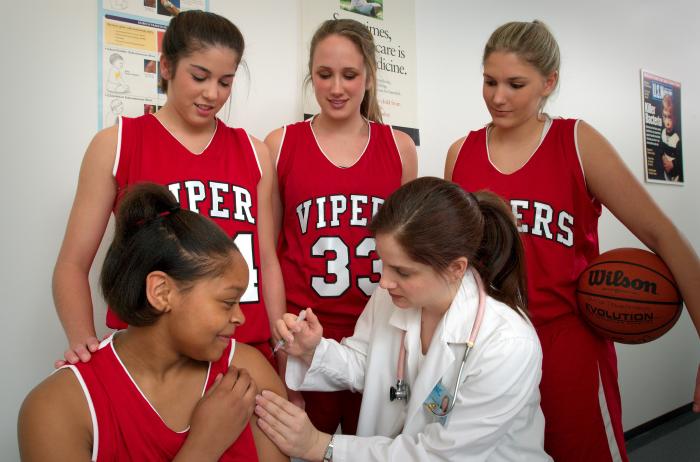Human papillomavirus (HPV) is a sexually transmitted virus that causes genital warts in men and women. It has been known for years that virtually all cases of cervical cancer are caused by this virus, making it one of the few clear cases of cancer caused by a viral infection. HPV also causes other forms of cancer as well.
In 2006, the FDA approved the first vaccine for HPV, Gardasil®, which is manufactured by Merck. The panel that makes official vaccine policy for the U.S. voted to make the vaccine part of the routine vaccine schedule for all children. It is recommended that girls receive the vaccine at age 11 or 12, along with other routine vaccines given at this age. The vaccine may be given as early as 9 years of age, according to the panel recommendations.
This vaccine is highly effective in preventing infection with certain strains of HPV and therefore in preventing most cases of cervical cancer, which kills over 4,000 women a year in the U.S. The vaccine works against the most common but not all strains of the virus; the strains contained in the vaccine cause about 70% of cervical cancer cases in the U.S. It is most effective when given before any infection occurs, and therefore is best given before sexual activity begins.
There is some controversy over the vaccine, particularly a concern perhaps that the vaccine will make sexual activity more likely or more common among teenagers. There is no evidence that this is the case. I am personally not in favor of treatments that seem to sanction sexual activity among teenagers either. Instead, I believe in abstinence until marriage and fidelity within marriage. I also do not usually believe in the message of, abstinence is best but I think this is usually sends a mixed message to teenagers.
However, at this time I do not believe that giving the vaccine necessarily communicates approval of sexual activity by either parent or physician; also, such treatments have not been shown to make sexual activity more likely. HPV infection is a chronic, long-term rather benign disease that can cause cancer many years in the future. Teenagers and young adults often make foolish, impulsive decisions and mistakes, and this vaccine can prevent some long-term consequences of those mistakes. Even if a person maintains abstinence until marriage, his or her spouse may have become infected in the past. Also, the vaccine is recommended at age 11, which is before girls are considering sexual activity. I am further reassured that neither the Family Research Council nor Focus on the Family, both conservative Christian family groups, are against the vaccine. They are against requiring parents to give the vaccine to their children, but they do not oppose the vaccine itself.
Depending on ones beliefs about vaccines in general and the risks and benefits of this vaccine, it is appropriate for some parents to give it to their daughters at age 11 as recommended. In other cases, it is appropriate to discuss the vaccine as part of a larger discussion about sexual choices and risks, a discussion all parents should be having with their teenage children. Girls do not need the vaccine until they are about to become sexually active, and ideally that is not before marriage.
Regardless of the personal decision whether to give it to one’s children, we have clearly entered a new and exciting age of developing vaccines to prevent cancer. It will be very interesting to see what the future holds.
Resources
HPV-9 – Gardasil-9 Vaccine Information Statement (VIS) (CDC)
HPV-4 – Gardasil Vaccine Information Statement (VIS) (CDC)
HPV-2 – Cervarix Vaccine Information Statement (VIS) (CDC)
References
Petrosky E, Bocchini JA, Hariri S, Chesson H, Curtis CR, Saraiya M, et al. Use of 9-Valent Human Papillomavirus (HPV) Vaccine: Updated HPV Vaccination Recommendations of the Advisory Committee on Immunization Practices MMWR. 2015;64(11);300-304.
Human Papillomavirus Vaccination: Recommendations of the Advisory Committee on Immunization Practices (ACIP) MMWR, August 29, 2014, Vo1 63, #RR05
Photo public domain courtesy Public Health Information Library/CDC


